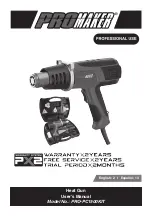
ADJUSTMENTS & OPERATION
ROTATING/CHANGING CUTTERHEAD CUTTER INSERTS
WARNING!
When checking cutter inserts, always make sure the machine is
disconnected from the power source.
Two T25 Torx bit screwdrivers are supplied with this machine to remove or adjust
the position of the cutter inserts secured in the cutterhead. The spiral cutterhead is
equipped with 60 indexable cutter inserts (15mm x 15mm x 2.5mm accessory
model KW-104) which can be rotated to reveal one of its four cutting edges. Once
a cutter insert becomes dull or damaged, simply rotate it 90° to reveal a fresh
cutting edge. In addition, each edge of the cutter inserts is marked with a number.
These reference numbers can be used as an indicator of which edges are used
and which are new. Once the reference mark revolves back around to its starting
position, the cutter insert should be replaced.
To check, adjust or replace the cutterhead cutter inserts:
1. Lift the Jointer table to gain access to the cutterhead.
2. Note the position of the reference number (A) Fig.14 on each cutter insert (B).
Using the T25 Torx bit screwdriver (C), loosen and remove cutter insert screw
(D) by turning counterclockwise.
Note:
The cutter insert and the seat should be as clean as possible. This will
prevent breakage of inserts and ensure proper insert alignment.
3. If cutter insert is damaged, replace it with a new one. If it is not damaged, rotate
it as shown in Fig.15.
4. Using a torque wrench, tighten to approximately 45-55 in/lbs torque to secure
the cutter insert.
5. Lower the Jointer table.
JOINTER TAbLE LOCk LEVER ADJUSTMENT
The Jointer table lock levers (A) Fig.5 should be facing down when locked. If an
adjustment to the table lock levers is required:
1. Disconnect the machine from the power source.
2. Unlock the table lock levers, and raise the Jointer table into the upright position.
3. Loosen the hex. nut (A) Fig.16 and adjust the locking shaft (B) in small
increments. Turning the locking shaft clockwise will tighten the lock lever motion,
and counterclockwise will loosen it.
4. Retighten the hex. nut (A) and test for proper locking function.
5. Repeat until adjustment is no longer necessary.
6. Repeat above steps for the other side.
CREATING A GAUGE bLOCk
A gauge block is used to check and adjust the Planer feed rollers and table. Cre-
ate a gauge block by using a piece of hardwood following the dimensions (mil-
limeters) shown in Fig.17 illustration.
FIGURE 14
1
2
3
t
1
2
3
t
1
2
3
t
1
2
3
t
FIGURE 15
FIGURE 16
FIGURE 17































